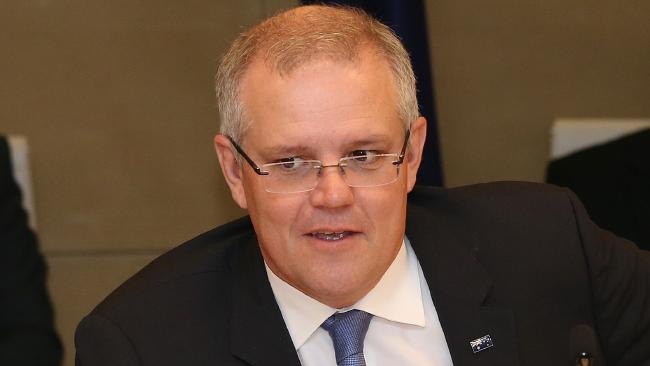OPINION: The good and bad of debt and government
FEDERAL BUDGET

LET’S start with some definitions.
Good Investment: spending on things like disadvantaged schools where you get more bang for your bucks rather than elite schools because at disadvantaged schools the extra money goes on teaching. Elite schools already spend enough on education so the extra money goes on diving pools and the like, and do not improve educational outcomes. So that is Bad Investment.
Good debt: Taking advantage of low interest rates for borrowing for projects like the Inland Rail rather than rail to a single coal mine, which would be Bad Debt. Inland Rail between Melbourne and Brisbane via Parkes will complete the standard gauge national line between the capitals; reduce congestion around Sydney; and take 100 B-double trucks off the road for each train.
Bad Debt: borrowing for any project announced by a politician before an independent body has done a cost-benefit analysis.
Good Government: Spending on good investments and only running up good debt.
Bad Government: Spending on bad investments and running up bad debt.
Good accounting practice: separating capital spending from recurrent spending, only counting the interest on the capital spending as recurrent spending.
Now we might be in a better position to see how Treasurer Scott Morrison’s Good Debt-Bad Debt project might pan out.
Morrison’s idea that he will change Budget practice to emphasise the operating deficit or surplus (by subtracting capital expenditure) is a sound one. The operating result has to include interest on debt and depreciation, but not the debt itself.
However, it met some immediate objections, some sound some not. The first objection was: “Why aren’t education and health seen as investments; why only infrastructure?” The implication is that it would be okay to borrow money for these things.
There are a lot of difficulties with this view. A better view is that education and health are really worthwhile, but rather than borrow to avoid cutting them, governments should increase revenue. Present taxpayers, who have benefited and continue to benefit from good health and education systems (and welfare, come to that) should provide for their upkeep. It is unfair to push those costs on to future generations in the form of debt and interest burdens.

To the extent that health and education are worthwhile spending it makes good sense to fund them well through higher taxes. The government is properly reallocating some personal spending (on a third car, a second boat, fashion items and so on) to education and health. But you can’t go too far. It is a matter of balance between private and public spending, of course.
Further, health, education and welfare, by and large, are consumed at once, so should be paid for now or gone without.
Infrastructure is different. People will be using the new road, railway, airport, hospital building or school for decades to come, so it is quite reasonable to amortise that cost over the life of the asset – typically 50 years for most big infrastructure assets.
So funding a $1 billion asset would affect the Budget operating result by $30 million in the first year, not the whole $1 billion. The $30 million is $15 million for interest at 1.5 per cent and $20 million for depreciation at 2 per cent.
This is a perfectly rational and inter-generationally sound way of accounting. But you can see the trap. A Treasurer in a government on a knife’s edge could announce the full funding of a swag of infrastructure that would bring warm fuzzy feelings to voters without worrying about running up a massive deficit and being charged with fiscal irresponsibility that would leave voters cold.
There is huge danger here. The Budget process is about the worst time and place to work out infrastructure spending because it is a secret process. “Wait and all will be revealed on Budget night,” the politicians’ mantra goes.
And on Budget night you get a whole lot of announceables – a freeway in this marginal electorate, a hospital in that marginal electorate, a new building for a foolishly relocated government agency in a minister’s electorate and so on.
This is not the way to allocate infrastructure projects.
When Anthony Albanese was Infrastructure Minister he set up an independent body, Infrastructure Australia, in 2008 and commissioned it to identify and list Australia’s infrastructure priorities and do a full economic analysis of all major proposals.
In theory this should put have put a stop to pork-barrelling, but it has not. The Grattan Institute published last year its survey of the first 15 years of this century’s major infrastructure spends and found that virtually every time a politician announced a project before an independent cost-benefit analysis was done, the project ran grossly over time and grossly over budget.
The trouble is that the political penalty for spending outside Infrastructure Australia’s priority list of financially sound projects is too low or non-existent. An electorate will reward a politician for attracting poor-returning infrastructure far more readily than punish the same politician for squandering public money on a financially flaky project.
The new emphasis on the “operating balance” as a measure of the Budget deficit or surplus makes a lot of financial sense and is inter-generationally fair. It is also used in other countries, but carries a lot risk in the hands of an irresponsible government.
When giving priority to infrastructure projects, politicians tend to ask themselves two questions before any others: Will this help me win my seat? And will this help my political party win more seats? National good, economic soundness and improved safety are merely coincidental.
Using the “operating balance” will also produce a lower deficit in years of high new infrastructure spend. But it will do nothing to correct the underlying fiscal imbalance created by the Howard Government’s generous tax breaks to middle- and high-income earners which have remained unaddressed by subsequent governments.
If government spending is around 26 per cent of GDP and revenue is around 23 per cent, ultimately something has to give. Attempts to cut spending have failed in the Senate, mainly because they have been seen to by unfair. The Coalition is on shaky enough ground as it is without any more cuts.
Eventually, it is going to have to do something about revenue, or alternatively we will have wait for a Labor Government to do something about it for us.
www.crispinhull.com.au
What's your take? Let us know in the comments below!
* Readers are encouraged to use their full details below to ensure comment legitimacy. Comments are the opinions of readers and do not represent the views of Newsport or its staff. Comments containing unlawful, obscene, defamatory or abusive material will not be published.

